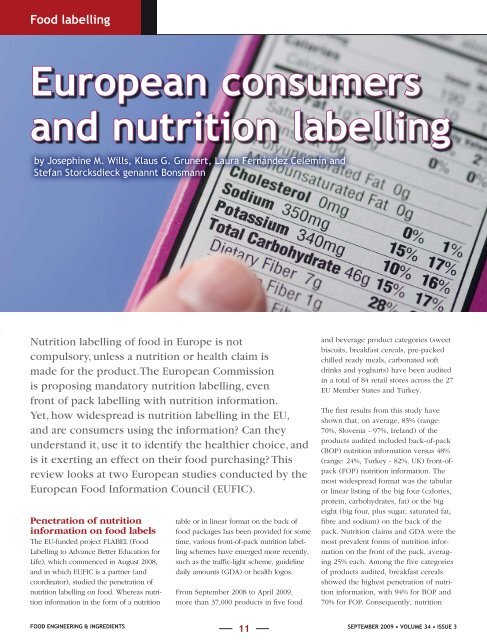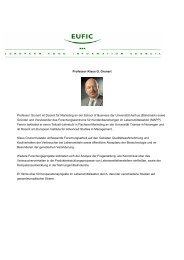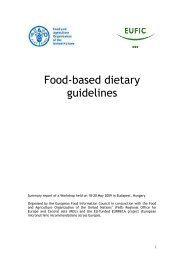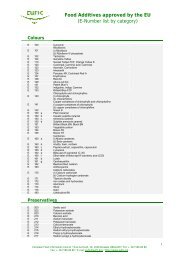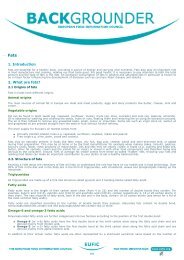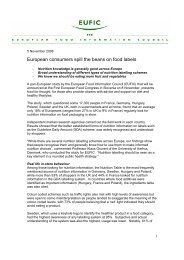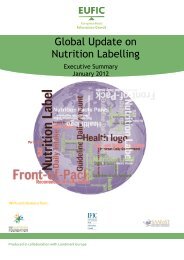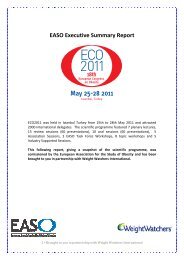european consumers and nutrition labelling - The European Food ...
european consumers and nutrition labelling - The European Food ...
european consumers and nutrition labelling - The European Food ...
Create successful ePaper yourself
Turn your PDF publications into a flip-book with our unique Google optimized e-Paper software.
<strong>Food</strong> <strong>labelling</strong><br />
<strong>European</strong> <strong>consumers</strong><br />
<strong>and</strong> <strong>nutrition</strong> <strong>labelling</strong><br />
by Josephine M. Wills, Klaus G. Grunert, Laura Fernández Celemín <strong>and</strong><br />
Stefan Storcksdieck genannt Bonsmann<br />
Nutrition <strong>labelling</strong> of food in Europe is not<br />
compulsory, unless a <strong>nutrition</strong> or health claim is<br />
made for the product. <strong>The</strong> <strong>European</strong> Commission<br />
is proposing m<strong>and</strong>atory <strong>nutrition</strong> <strong>labelling</strong>, even<br />
front of pack <strong>labelling</strong> with <strong>nutrition</strong> information.<br />
Yet, how widespread is <strong>nutrition</strong> <strong>labelling</strong> in the EU,<br />
<strong>and</strong> are <strong>consumers</strong> using the information? Can they<br />
underst<strong>and</strong> it, use it to identify the healthier choice, <strong>and</strong><br />
is it exerting an effect on their food purchasing? This<br />
review looks at two <strong>European</strong> studies conducted by the<br />
<strong>European</strong> <strong>Food</strong> Information Council (EUFIC).<br />
Penetration of <strong>nutrition</strong><br />
information on food labels<br />
<strong>The</strong> EU-funded project FLABEL (<strong>Food</strong><br />
Labelling to Advance Better Education for<br />
Life), which commenced in August 2008,<br />
<strong>and</strong> in which EUFIC is a partner (<strong>and</strong><br />
coordinator), studied the penetration of<br />
<strong>nutrition</strong> <strong>labelling</strong> on food. Whereas <strong>nutrition</strong><br />
information in the form of a <strong>nutrition</strong><br />
table or in linear format on the back of<br />
food packages has been provided for some<br />
time, various front-of-pack <strong>nutrition</strong> <strong>labelling</strong><br />
schemes have emerged more recently,<br />
such as the traffic-light scheme, guideline<br />
daily amounts (GDA) or health logos.<br />
From September 2008 to April 2009,<br />
more than 37,000 products in five food<br />
<strong>and</strong> beverage product categories (sweet<br />
biscuits, breakfast cereals, pre-packed<br />
chilled ready meals, carbonated soft<br />
drinks <strong>and</strong> yoghurts) have been audited<br />
in a total of 84 retail stores across the 27<br />
EU Member States <strong>and</strong> Turkey.<br />
<strong>The</strong> first results from this study have<br />
shown that, on average, 85% (range:<br />
70%, Slovenia - 97%, Irel<strong>and</strong>) of the<br />
products audited included back-of-pack<br />
(BOP) <strong>nutrition</strong> information versus 48%<br />
(range: 24%, Turkey - 82%, UK) front-ofpack<br />
(FOP) <strong>nutrition</strong> information. <strong>The</strong><br />
most widespread format was the tabular<br />
or linear listing of the big four (calories,<br />
protein, carbohydrates, fat) or the big<br />
eight (big four, plus sugar, saturated fat,<br />
fibre <strong>and</strong> sodium) on the back of the<br />
pack. Nutrition claims <strong>and</strong> GDA were the<br />
most prevalent forms of <strong>nutrition</strong> information<br />
on the front of the pack, averaging<br />
25% each. Among the five categories<br />
of products audited, breakfast cereals<br />
showed the highest penetration of <strong>nutrition</strong><br />
information, with 94% for BOP <strong>and</strong><br />
70% for FOP. Consequently, <strong>nutrition</strong><br />
<strong>Food</strong> Engineering & Ingredients<br />
11<br />
september 2009 • Volume 34 • Issue 3
<strong>Food</strong> <strong>labelling</strong><br />
a GDA label before. In Sweden, the keyhole<br />
logo achieved an overall consumer<br />
awareness of over 95%. In the UK, most<br />
of the respondents were also aware of<br />
the traffic-light system (79%). Among<br />
the various systems, <strong>consumers</strong> looked<br />
mostly at the <strong>nutrition</strong> table <strong>and</strong> GDA for<br />
<strong>nutrition</strong> information.<br />
9<br />
information seems to be widely available<br />
on food products in Europe, despite the<br />
fact that its provision is voluntary if there<br />
are no <strong>nutrition</strong> or health claims on<br />
the product.<br />
<strong>European</strong> <strong>consumers</strong><br />
<strong>and</strong> <strong>nutrition</strong><br />
Another study, by EUFIC in collaboration<br />
with Professor Klaus Grunert, University<br />
of Aarhus, Denmark, was designed to<br />
assess <strong>consumers</strong>’ knowledge of <strong>nutrition</strong>,<br />
as well as their use of <strong>nutrition</strong> <strong>labelling</strong><br />
when choosing products in a store. <strong>The</strong><br />
study was carried out in six countries<br />
(UK, Germany, Pol<strong>and</strong>, Hungary, France,<br />
Sweden) from February 2008 to February<br />
2009, <strong>and</strong> consisted of three parts:<br />
1) Observing shoppers’ behaviour during<br />
their product choice at the supermarket<br />
aisle;<br />
2) An interview in the store to ascertain<br />
the information for which they had<br />
looked <strong>and</strong> where on the label they<br />
had found it;<br />
3) A questionnaire to fill in at home <strong>and</strong><br />
return, looking at use <strong>and</strong> underst<strong>and</strong>ing<br />
of <strong>nutrition</strong> information <strong>and</strong> knowledge<br />
of <strong>nutrition</strong>.<br />
More than 11,700 in-store interviews were<br />
carried out <strong>and</strong> 6,000 of these participants<br />
returned the at-home questionnaire.<br />
21<br />
420<br />
32 21<br />
Examples of different <strong>nutrition</strong> <strong>labelling</strong> symbols <strong>and</strong> systems used in Europe.<br />
Nutrition knowledge<br />
Respondents had a reasonably good<br />
knowledge of <strong>nutrition</strong>, with the most<br />
positive answers coming from the UK.<br />
<strong>The</strong>y knew they should eat lots of fruits<br />
<strong>and</strong> vegetables, but few knew that eating<br />
a lot of starchy foods (such as bread,<br />
rice, pasta <strong>and</strong> potatoes) is recommended.<br />
Many <strong>consumers</strong> believed that<br />
foods high in fat, sugar <strong>and</strong> salt should<br />
be avoided, rather than that intake<br />
should be restricted. More than a third<br />
of respondents tended to overestimate<br />
children’s calorie needs, thinking they<br />
needed more calories than an adult<br />
male – a point worth considering as we<br />
continue to address childhood obesity.<br />
<strong>The</strong>re is confusion concerning the<br />
different types of fat, with the health<br />
implications of saturated fat, trans fat <strong>and</strong><br />
omega-3 consumption being fairly well<br />
understood, whereas polyunsaturated<br />
fatty acids are less familiar.<br />
Labelling awareness,<br />
underst<strong>and</strong>ing <strong>and</strong> ability<br />
to make health inferences<br />
Most <strong>consumers</strong> were aware of the major<br />
<strong>nutrition</strong> <strong>labelling</strong> schemes found in the<br />
supermarket in which they shopped.<br />
About 60% (range: 40%, Sweden - 90%,<br />
UK) of respondents reported having seen<br />
When focusing on objective underst<strong>and</strong>ing,<br />
the meaning of the keyhole logo was<br />
broadly understood by the respondents in<br />
Sweden. However, colour-coded systems<br />
were often misinterpreted by <strong>consumers</strong><br />
in the UK <strong>and</strong> France. Most respondents<br />
in both countries (73% in the UK, 63%<br />
in France) exaggerated the meaning of<br />
the highest nutrient levels (red in the<br />
UK, orange in France). <strong>The</strong> UK <strong>consumers</strong><br />
wrongly believed that the red colour<br />
meant they “should try not to eat this<br />
product”, while the correct definition is<br />
“It’s fine to eat this product occasionally<br />
as a treat.”<br />
A majority of <strong>consumers</strong> (between<br />
66% <strong>and</strong> 88%) in all six countries could<br />
correctly use the <strong>labelling</strong> system to<br />
identify the healthier option between different<br />
products within the same category<br />
regardless of the <strong>labelling</strong><br />
system provided.<br />
Consumers’ awareness, underst<strong>and</strong>ing <strong>and</strong><br />
ability to make correct health inferences<br />
are linked to their knowledge of <strong>nutrition</strong>,<br />
age, social class <strong>and</strong> interest in healthy<br />
eating. <strong>The</strong>se results suggest that improving<br />
<strong>consumers</strong>’ knowledge of <strong>nutrition</strong><br />
could help them interpret <strong>nutrition</strong><br />
<strong>labelling</strong> correctly.<br />
Consumers’ actual use of<br />
<strong>nutrition</strong> <strong>labelling</strong><br />
Most respondents were able to use <strong>nutrition</strong><br />
information when prompted, but<br />
do they use it when shopping? In the<br />
EUFIC study, <strong>consumers</strong> were recruited in<br />
supermarkets after they had just chosen<br />
a product (from one of the six different<br />
product categories). Fewer than one-third<br />
of <strong>consumers</strong> had looked for <strong>nutrition</strong><br />
information on these packs (range: 9%<br />
France to 27% UK).<br />
<strong>Food</strong> Engineering & Ingredients<br />
12<br />
september 2009 • Volume 34 • Issue 3
<strong>The</strong> main indicators used to infer healthiness<br />
were calories <strong>and</strong> fat. Salt was only<br />
a major concern for <strong>consumers</strong> in the UK.<br />
Nutrition information was mainly drawn<br />
from the <strong>nutrition</strong> table or GDA information,<br />
especially in the UK, France <strong>and</strong><br />
Germany. Of the six product categories<br />
considered, respondents spent the most<br />
time h<strong>and</strong>ling ready meals, but were most<br />
likely to look for <strong>nutrition</strong> information on<br />
yoghurts <strong>and</strong> breakfast cereals.<br />
Conclusion<br />
<strong>The</strong> penetration of <strong>nutrition</strong> <strong>labelling</strong> in<br />
Europe is high. <strong>The</strong> majority of <strong>consumers</strong><br />
have a reasonable knowledge of <strong>nutrition</strong><br />
<strong>and</strong> are able to use <strong>nutrition</strong> information<br />
to identify a healthier product. But only a<br />
minority actually looks at this information<br />
when shopping, <strong>and</strong> this is influenced by<br />
an interest in healthy eating. This raises<br />
the question of how <strong>consumers</strong> can be<br />
encouraged to look for <strong>nutrition</strong> information<br />
on food labels.<br />
Acknowledgement<br />
FLABEL - <strong>Food</strong> Labelling to Advance Better<br />
Education for Life - receives research<br />
funding from the <strong>European</strong> Community’s<br />
Seventh Framework Programme (Contract<br />
n° 211905).<br />
*Corresponding author<br />
1. <strong>European</strong> <strong>Food</strong> Information Council<br />
(EUFIC)<br />
Rue Guimard 19, B-1040<br />
Brussels, Belgium<br />
2. MAPP-Centre for Research on Customer<br />
Relations in the <strong>Food</strong> Sector<br />
University of Aarhus<br />
Haslegaardsvej 10, 8210<br />
Aarhus V, Denmark<br />
<strong>Food</strong> <strong>and</strong> Drink Companies interested in<br />
learning more about the work of EUFIC,<br />
or membership, please contact jo.wills@<br />
eufic.org<br />
AVT, <strong>Food</strong> Engineering & Ingredients, 134 x 206 mm, CC-en31-AZ023_07/09<br />
Life is liquid. (8)<br />
Techno<br />
for softies.<br />
Comments on<br />
this article?<br />
feel free to post them at<br />
www.fei-online.com/comment/<strong>nutrition</strong>_<strong>labelling</strong><br />
References<br />
1. Grunert K G, Wills J. A review of <strong>European</strong><br />
research on consumer response to <strong>nutrition</strong><br />
information on food labels J Public Health<br />
2007; 15: 385-399.<br />
Webinar presentation of FLABEL results on<br />
“Current penetration of <strong>nutrition</strong> information<br />
on food labels in the EU 27 & Turkey”.<br />
Available at : http://www.flabel.org/en/<br />
basic100036.html<br />
2. Pan-<strong>European</strong> consumer research on in-store<br />
observation, underst<strong>and</strong>ing & use of <strong>nutrition</strong><br />
information on food labels, combined with<br />
assessing <strong>nutrition</strong> knowledge. EUFIC Forum<br />
N°4, February 2009. Accessible at: http://<br />
www.eufic.org/upl/1/en/doc/Pan-EU%20<br />
executive%20summary%20FINAL.pdf<br />
Hall B6<br />
Admit it: at 1,000 bpm, your pulse would quicken too.<br />
But don’t worry: our machines operate with such reassuringly<br />
gentle precision that even the most sensitive<br />
of products, the most fussy of containers, will actually<br />
revel in the speed. Whatever you want to bottle, label<br />
or package: you simply tell us the targeted tempo. And<br />
we supply the equipment that revs up the rhythm of<br />
your production process.<br />
<strong>The</strong> authors<br />
Josephine M. Wills 1 *, Klaus G. Grunert<br />
2 , Laura Fernández Celemín 1 , Stefan<br />
Storcksdieck genannt Bonsmann 1<br />
<strong>Food</strong> Engineering & Ingredients<br />
Find out more at:<br />
www.krones.com/en/solutions<br />
13<br />
www.fei-online.com & search 10463<br />
september 2009 • Volume 34 • Issue 3


